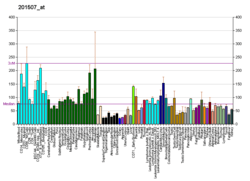Prefoldin subunit 1 is a protein that in humans is encoded by the PFDN1 gene.[5][6]
This gene encodes a member of the prefoldin beta subunit family. The encoded protein is one of six subunits of prefoldin, a molecular chaperone complex that binds and stabilizes newly synthesized polypeptides, thereby allowing them to fold correctly. The complex, consisting of two alpha and four beta subunits, forms a double beta barrel assembly with six protruding coiled-coils.[6]
Further reading
- Hartl FU, Hayer-Hartl M (2002). "Molecular chaperones in the cytosol: from nascent chain to folded protein". Science. 295 (5561): 1852–8. doi:10.1126/science.1068408. PMID 11884745.
- Maruyama K, Sugano S (1994). "Oligo-capping: a simple method to replace the cap structure of eukaryotic mRNAs with oligoribonucleotides". Gene. 138 (1–2): 171–4. doi:10.1016/0378-1119(94)90802-8. PMID 8125298.
- Iijima M, Kano Y, Nohno T, Namba M (1996). "Cloning of cDNA with possible transcription factor activity at the G1-S phase transition in human fibroblast cell lines". Acta Med. Okayama. 50 (2): 73–7. PMID 8744932.
- Suzuki Y, Yoshitomo-Nakagawa K, Maruyama K, et al. (1997). "Construction and characterization of a full length-enriched and a 5'-end-enriched cDNA library". Gene. 200 (1–2): 149–56. doi:10.1016/S0378-1119(97)00411-3. PMID 9373149.
- Horrigan SK, Bartoloni L, Speer MC, et al. (1999). "A radiation hybrid breakpoint map of the acute myeloid leukemia (AML) and limb-girdle muscular dystrophy 1A (LGMD1A) regions of chromosome 5q31 localizing 122 expressed sequences". Genomics. 57 (1): 24–35. doi:10.1006/geno.1999.5765. PMID 10191080.
- Hansen WJ, Cowan NJ, Welch WJ (1999). "Prefoldin–Nascent Chain Complexes in the Folding of Cytoskeletal Proteins". J. Cell Biol. 145 (2): 265–77. doi:10.1083/jcb.145.2.265. PMC 2133115. PMID 10209023.
- Cowan NJ, Lewis SA (2002). "A chaperone with a hydrophilic surface". Nat. Struct. Biol. 6 (11): 990–1. doi:10.1038/14870. PMID 10542082.
- Munnia A, Schütz N, Romeike BF, et al. (2001). "Expression, cellular distribution and protein binding of the glioma amplified sequence (GAS41), a highly conserved putative transcription factor". Oncogene. 20 (35): 4853–63. doi:10.1038/sj.onc.1204650. PMID 11521196.
- Rommelaere H, De Neve M, Neirynck K, et al. (2001). "Prefoldin recognition motifs in the nonhomologous proteins of the actin and tubulin families". J. Biol. Chem. 276 (44): 41023–8. doi:10.1074/jbc.M106591200. PMID 11535601.
- Martín-Benito J, Boskovic J, Gómez-Puertas P, et al. (2003). "Structure of eukaryotic prefoldin and of its complexes with unfolded actin and the cytosolic chaperonin CCT". EMBO J. 21 (23): 6377–86. doi:10.1093/emboj/cdf640. PMC 136944. PMID 12456645.
- Strausberg RL, Feingold EA, Grouse LH, et al. (2003). "Generation and initial analysis of more than 15,000 full-length human and mouse cDNA sequences". Proc. Natl. Acad. Sci. U.S.A. 99 (26): 16899–903. doi:10.1073/pnas.242603899. PMC 139241. PMID 12477932.
- Bruneel A, Labas V, Mailloux A, et al. (2004). "Proteomic study of human umbilical vein endothelial cells in culture". Proteomics. 3 (5): 714–23. doi:10.1002/pmic.200300409. PMID 12748950.
- Gstaiger M, Luke B, Hess D, et al. (2003). "Control of nutrient-sensitive transcription programs by the unconventional prefoldin URI". Science. 302 (5648): 1208–12. doi:10.1126/science.1088401. PMID 14615539.
- Simons CT, Staes A, Rommelaere H, et al. (2004). "Selective contribution of eukaryotic prefoldin subunits to actin and tubulin binding". J. Biol. Chem. 279 (6): 4196–203. doi:10.1074/jbc.M306053200. PMID 14634002.
- Ota T, Suzuki Y, Nishikawa T, et al. (2004). "Complete sequencing and characterization of 21,243 full-length human cDNAs". Nat. Genet. 36 (1): 40–5. doi:10.1038/ng1285. PMID 14702039.
- Gerhard DS, Wagner L, Feingold EA, et al. (2004). "The Status, Quality, and Expansion of the NIH Full-Length cDNA Project: The Mammalian Gene Collection (MGC)". Genome Res. 14 (10B): 2121–7. doi:10.1101/gr.2596504. PMC 528928. PMID 15489334.
- Stelzl U, Worm U, Lalowski M, et al. (2005). "A human protein-protein interaction network: a resource for annotating the proteome". Cell. 122 (6): 957–68. doi:10.1016/j.cell.2005.08.029. PMID 16169070.
- Rual JF, Venkatesan K, Hao T, et al. (2005). "Towards a proteome-scale map of the human protein-protein interaction network". Nature. 437 (7062): 1173–8. doi:10.1038/nature04209. PMID 16189514.




